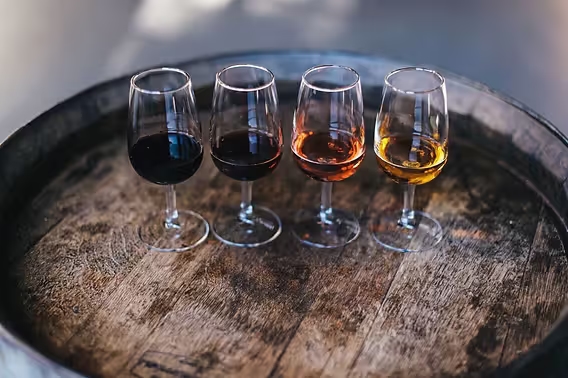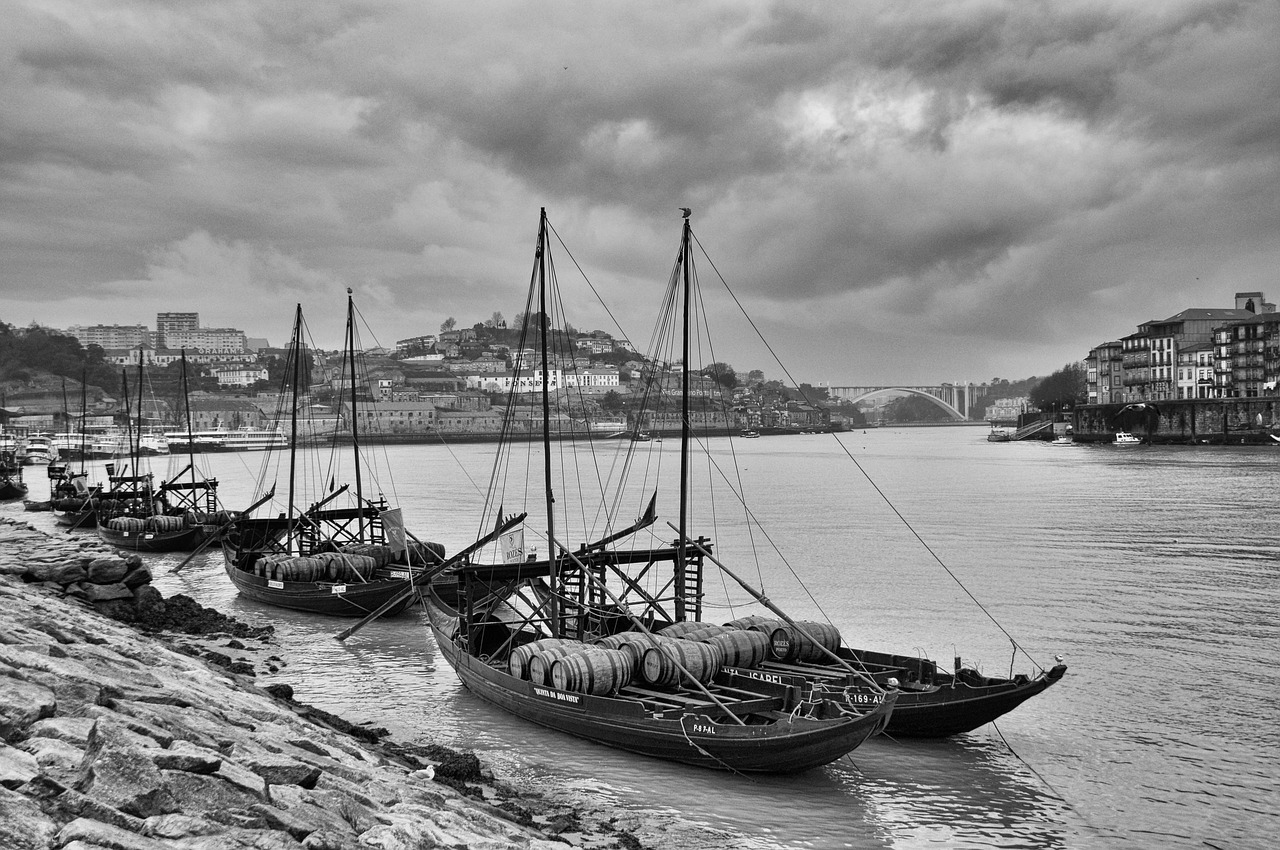
Port wine is a true gem of Portugal’s wine heritage, admired worldwide for its richness, complexity, and fascinating history. It’s produced exclusively in the Douro Valley, a breathtaking region classified as a UNESCO World Heritage Site, where vines cling to steep terraces as if reaching for the sky. This fortified wine embodies both Portuguese tradition and the expertise of generations of passionate winemakers, the time artisans who age wine the way others nurture love stories. But Port is much more than a drink : it’s a living chapter of Portuguese culture, a symbol of conviviality and gastronomy…in short, a glass that tells the story of a nation.
A Brief History, From Ancient Origins to Global Fame
As with many great things, Port was born out of a happy accident ! Its roots go back to Roman times, when vines were first planted in the Douro Valley. The Romans, already keen wine enthusiasts, introduced the earliest winemaking techniques and grape varieties adapted to the region’s harsh yet generous climate. But the Port we know today, the amber-hued nectar that graces our glasses, was actually the result of a lucky 17th-century trade mishap. During the wars with France, British merchants found themselves short of French wine and turned to Portugal instead. To prevent the wine from spoiling on the long sea journey to London, they added a touch of grape spirit (“aguardente”).
The result ? A richer, sweeter, more stable wine and, of course, an instant hit. Proof that even diplomatic crises can lead to delicious outcomes. Port is made from native Portuguese grapes, including Touriga Nacional, Touriga Franca, Tinta Roriz, Tinta Barroca, and Tinto Cão. It all starts with hand harvesting (usually in September, when the Douro smells of ripe grapes). The grapes are crushed, fermentation begins, and then grape spirit is added to stop the process, preserving the natural sugars. That little “pause” creates the magic : a naturally sweet, fortified wine with around 19-20% alcohol.
A perfect balance between strength and sweetness…. just like the Portuguese themselves !

Vila Nova de Gaia, The Beating Heart of Port
Just across the river from Porto lies Vila Nova de Gaia, the birthplace of Port wine as we know it. This charming town is home to over 60 historic lodges, where the wine slowly matures in oak casks. Around 20 of them are open to the public, perfect for a wine-tasting adventure (often offered in English, French or Spanish… and sometimes in melodic Portuguese if the guide is in a good mood or has already had a little taste!).
Some must-visit cellars
Taylor’s : founded in 1692, one of the oldest Port houses. Incredible panoramic views and a fantastic interactive museum.
Sandeman : famous for its “Caped Man” logo. A modern, almost theatrical experience.
Cálem : right by the river, offering guided tours and evening fado concerts, a perfect combination (and personally, one of my favourites !).
Ferreira : a 100% Portuguese house, ideal for learning about the local history of Port.
Burmester : more discreet, located in an 18th-century building. Tradition, innovation, and elegance blend seamlessly here.
Insider tip : visit at the end of the afternoon, the golden Douro light during a Tawny tasting is almost mystical. Or even better, head to the Porto Cruz rooftop bar at sunset…the view over the Dom Luís I Bridge is absolutely magical.
The Different Types of Port
There are several styles of Port, each with its own personality, a bit like a big, colourful Portuguese family !
Ruby Port
Young, fruity, and vibrant, aged 2-3 years in oak casks. The most approachable and lively style.
Tawny Port
Aged longer, developing nutty, dried fruit aromas. A contemplative wine, best enjoyed slowly.
White Port
Made from white grapes, available in dry or sweet styles. Perfect as an aperitif, especially in summer with ice and an orange slice. The ideal companion for sunny afternoons and light salads (that’s how I like mine !).
Rosé Port
The light and modern version, great for trendy cocktails, the famous Porto Tonic is a must-try !
Vintage Port
The king of Ports ! Produced only in exceptional years, aged 2 years in cask then bottled, an emotional as well as a gastronomic investment.
LBV (Late Bottled Vintage)
Similar to Vintage but aged longer in cask ; more accessible, but equally noble.
How to Taste Port Like a Pro ? (our tips)
Tasting Port is almost a ritual… so grab a pen, here are the essentials !
Serving temperature for Ruby 12-16°C (cool, but not cold) ; Tawny 15-18°C ; and White around 10°C (serve well chilled)
The right glass : a tulip-shaped glass, medium-sized, with a slightly narrow opening to concentrate aromas. No need for a giant red wine glass…Port is meant to be savoured, not gulped.
Food pairings
Ruby : delicious with dark chocolate or strong cheese.
Tawny : pairs beautifully with nuts, blue cheese or nutty desserts.
White : perfect with seafood, fresh cheese, or summer salads.
Chef’s tip : a splash of Port in a sauce, dessert or to flambé duck breast, and everyone will think you’ve trained at a Lisbon culinary school (true story !).
Frequently Asked Questions
Is Port a natural wine ?
Yes, it’s fortified : fermentation is stopped with grape spirit, preserving the grape’s natural sugars.
How is it different from red wine ?
Red wine ferments completely, while Port stops halfway, that’s why it’s sweet and rich.
How should you drink it ?
At room temperature or slightly chilled. Ruby and Tawny are ideal after a meal ; White Port makes a lovely aperitif.
Is Port “cooked” ?
No ! It’s fortified, not cooked, this isn’t mulled wine !
Does it contain a lot of sugar ?
Yes, that’s part of its charm. It’s what gives Port its roundness and warmth… but beware, one glass is perfect, a whole bottle is another story !
For anyone visiting Portugal and especially the Porto region, tasting Port is far more than a gourmet pleasure. It’s a journey through time, a sip of history, and a love letter to the Douro. Between hypnotic landscapes, centuries-old cellars and the clink of glasses at sunset, Port reveals itself as a truly complete experience, cultural, sensory, and just a little bit magical.
Share this article
Suggested articles

Canned fish, from everyday staple to gourmet art
In Portugal, canned fish embodies a true culinary tradition, an artisanal savoir-faire, and a way to elevate everyday meals. Sardines, tuna, mackerel, clams, and even octopus, each tin tells the story of fishermen, Portugal’s Atlantic coastlines, and the nation’s deep passion for the sea. And if you still think canned fish is just for lazy nights or quick fixes… think again !

Portuguese Design, Between Sobriety, Tradition and Modernity
Between Sobriety, Tradition and Modernity Portugal doesn’t captivate only with its sunny beaches, generous cuisine, or rich historical heritage. Behind the colorful streets and the shimmering azulejos lies a richness that’s sometimes less visible but just as fascinating : its design. Discreet, refined, and sometimes bold, Portuguese design reflects a unique identity at the crossroads between traditional craftsmanship and contemporary modernity. And let’s be honest, it’s hard not to fall for this perfect balance between simplicity and elegance!

Traditional Markets, Where to Treasure Hunt and Taste Local Delights
Portugal, with its rich culture and gastronomy, offers locals and visitors a truly unique experience through its traditional markets, commonly known as feiras. These places aren’t just rows of stalls; they’re real stages of daily life, the beating heart of towns and villages, where gastronomy, craftsmanship, music, and of course…

Portuguese Olive Oils, a Green Gold to Discover
Olive oil is much more than just an ingredient in Portugal; it embodies a millennia-old tradition, ancestral know-how, and a true source of national pride ! Nicknamed “liquid gold,” Portuguese olive oil is renowned for its exceptional quality and its central role in the country’s gastronomy. Since Antiquity, olive oil has been at the heart of Portuguese culture and cuisine. Today, it is even internationally recognised for its outstanding quality and unique flavours.


